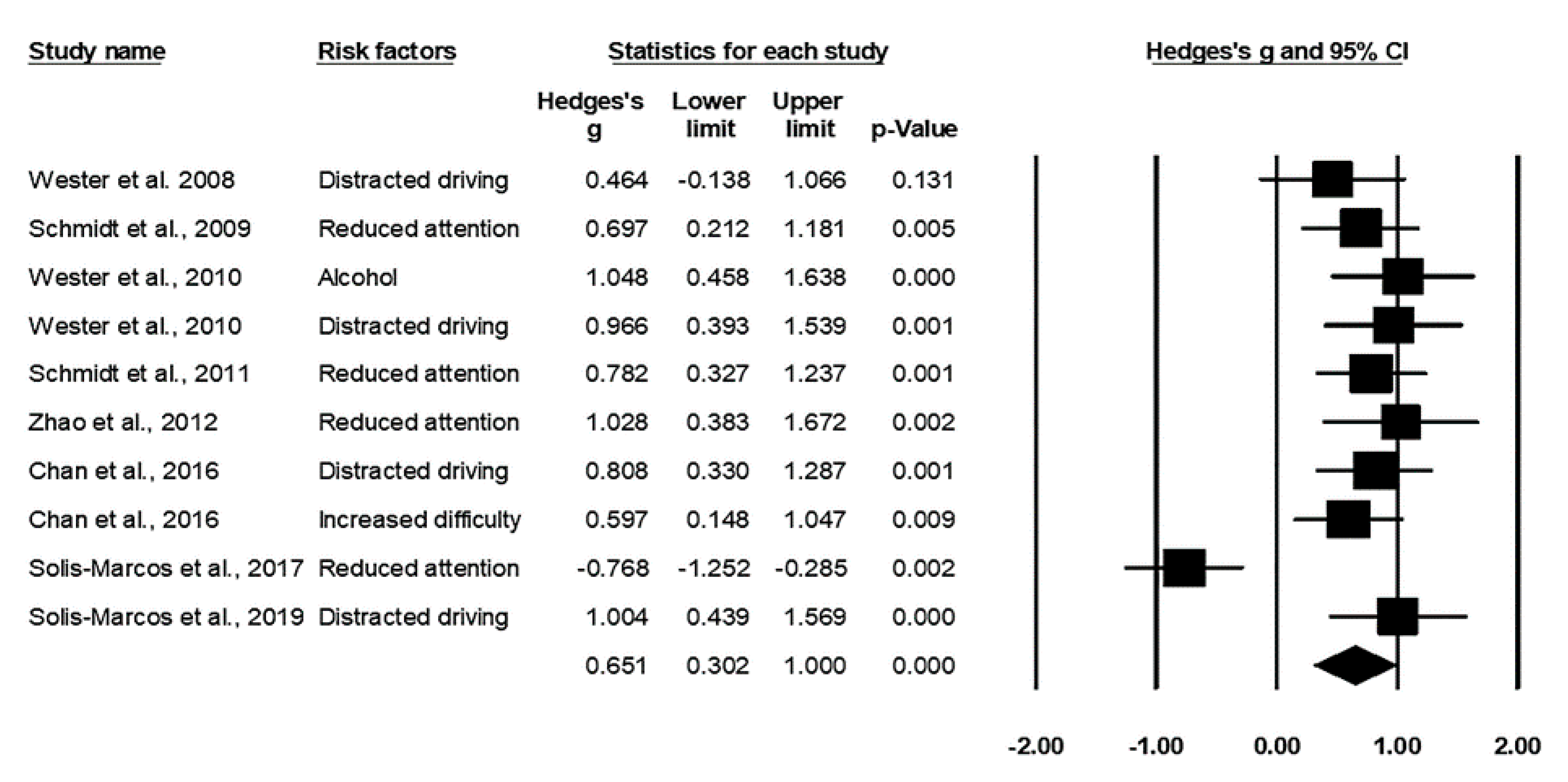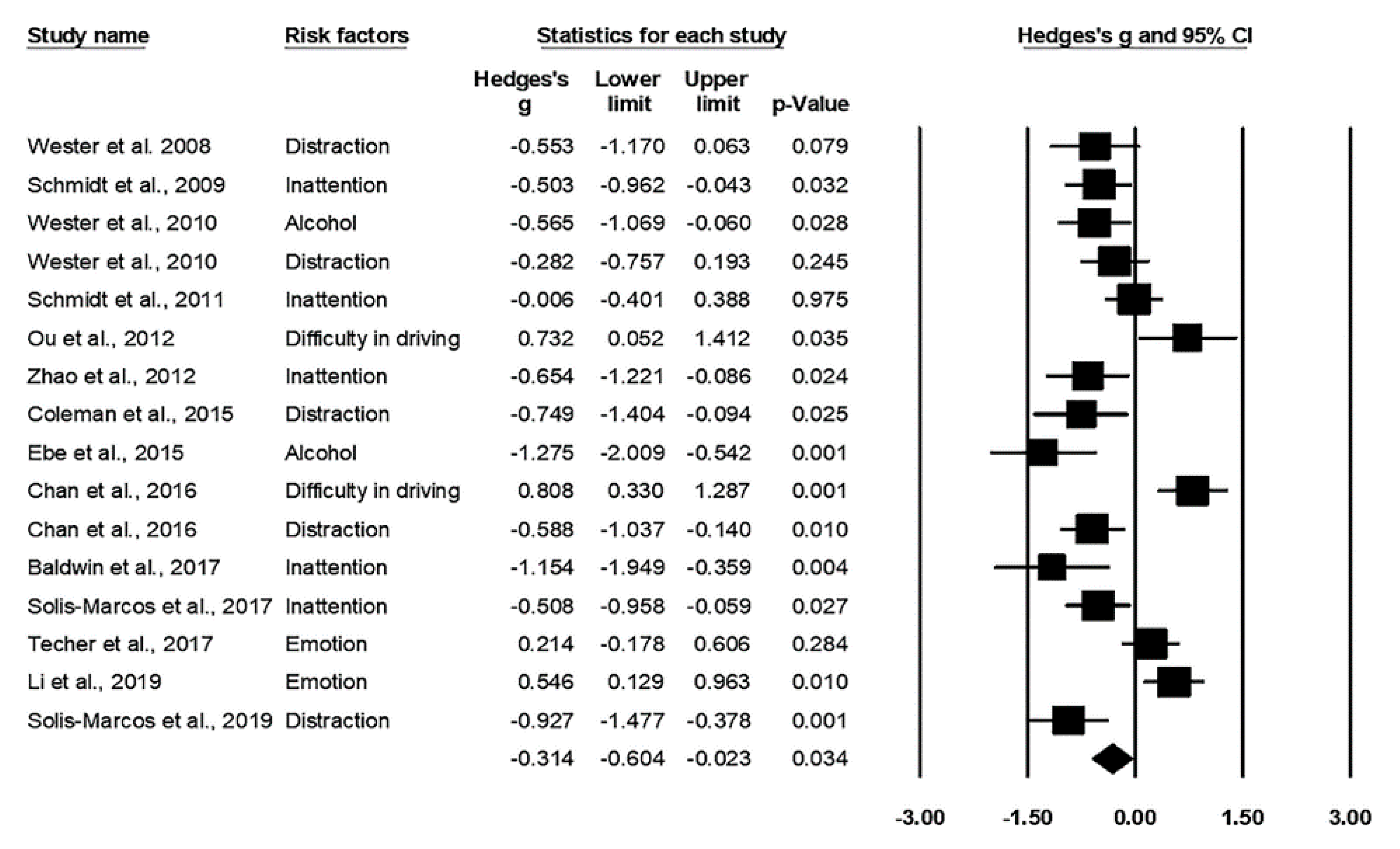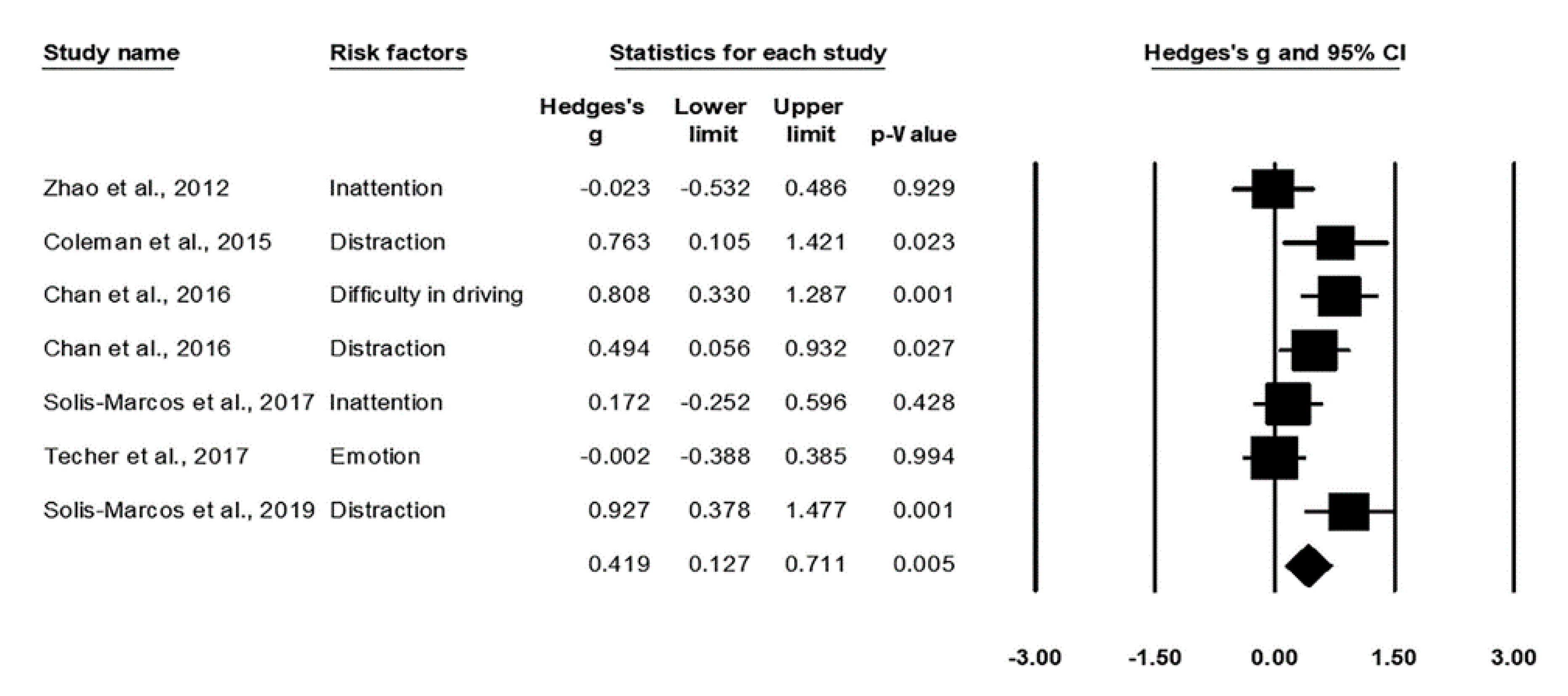P300 Measures and Drive-Related Risks: A Systematic Review and Meta-Analysis
Abstract
:1. Introduction
2. Materials and Methods
2.1. Search Strategy
2.2. Inclusion Criteria
2.3. Data Extraction and Synthesis
2.4. Statistical Analysis
3. Results
3.1. Study Selection
3.2. Summary of the Risk Factors in the Driving Tasks
3.3. Meta-Analysis on Behavioral Measures
3.3.1. Reaction Time
3.3.2. Driving Performance
3.4. Meta-Analysis on P300 Variations
3.4.1. Amplitude
3.4.2. Latency
4. Discussion
4.1. Summary of the Main Findings
4.2. P300 Components—Predictors for Driving Behaviors
4.3. Application of P300 Research to Reduce Road Traffic Accidents
5. Limitations and Future Direction
6. Conclusions
Author Contributions
Funding
Conflicts of Interest
References
- World Health Organization. Global Status Report on Road Safety 2018: Summary; No. WHO/NMH/NVI/18.20; World Health Organization: Geneva, Switzerland, 2018. [Google Scholar]
- Valen, A.; Bogstrand, S.T.; Vindenes, V.; Frost, J.; Larsson, M.; Holtan, A.; Gjerde, H. Driver-related risk factors of fatal road traffic crashes associated with alcohol or drug impairment. Accid. Anal. Prev. 2019, 131, 191–199. [Google Scholar] [CrossRef] [PubMed]
- Lal, S.; Craig, A.; Boord, P.; Kirkup, L.; Nguyen, H.T. Development of an algorithm for an EEG-based driver fatigue countermeasure. J. Saf. Res. 2003, 34, 321–328. [Google Scholar] [CrossRef]
- Brown, I.D. Prospects for technological countermeasures against driver fatigue. Accid. Anal. Prev. 1997, 29, 525–531. [Google Scholar] [CrossRef]
- Parasuraman, R. Event-related brain potentials and human factors research. In Event-Related Brain Potentials: Basic Issues and Applications; Rohrbaugh, W., Parasuraman, R., Johnson, R., Jr., Eds.; Oxford Press: New York, NY, USA, 1990. [Google Scholar]
- Gevins, A.; Leong, H.; Du, R.; Smith, M.E.; Le, J.; DuRousseau, D.; Zhang, J.; Libove, J. Towards measurement of brain function in operational environments. Boil. Psychol. 1995, 40, 169–186. [Google Scholar] [CrossRef]
- Van Erp, J.B.F.; Brouwer, A.-M.; Zander, T.O. Editorial: Using neurophysiological signals that reflect cognitive or affective state. Front. Mol. Neurosci. 2015, 9, 515. [Google Scholar] [CrossRef] [Green Version]
- Borghini, G.; Aricò, P.; Di Flumeri, G.; Cartocci, G.; Colosimo, A.; Bonelli, S.; Golfetti, A.; Imbert, J.P.; Granger, G.; Benhacene, R.; et al. EEG-based cognitive control behaviour assessment: An ecological study with professional air traffic controllers. Sci. Rep. 2017, 7, 547. [Google Scholar] [CrossRef]
- Blackwood, D.H.; Muir, W.J. Cognitive brain potentials and their application. Br. J. Psychiatry 1990, 157, 96–101. [Google Scholar] [CrossRef]
- Sur, S.; Sinha, V.K. Event-related potential: An overview. Ind. Psychiatry J. 2009, 18, 70–73. [Google Scholar] [CrossRef]
- Peterson, N.N.; Schroeder, C.E.; Arezzo, J.C. Neural generators of early cortical somatosensory evoked potentials in the awake monkey. Electroencephalogr. Clin. Neurophysiol. Potentials Sect. 1995, 96, 248–260. [Google Scholar] [CrossRef]
- Solis-Marcos, I.; Kircher, K. Event-related potentials as indices of mental workload while using an in-vehicle information system. Cogn. Technol. Work. 2018, 21, 55–67. [Google Scholar] [CrossRef] [Green Version]
- Chan, M.; Singhal, A. Emotion matters: Implications for distracted driving. Saf. Sci. 2015, 72, 302–309. [Google Scholar] [CrossRef]
- Kok, A. Event-related-potential (ERP) reflections of mental resources a review and synthesis. Boil. Psychol. 1997, 45, 19–56. [Google Scholar] [CrossRef]
- Arvaneh, M.; Robertson, I.H.; Ward, T.E. A P300-Based Brain-Computer Interface for Improving Attention. Front. Hum. Neurosci. 2019, 12, 12. [Google Scholar] [CrossRef] [PubMed] [Green Version]
- Polich, J. Updating P300: An integrative theory of P3a and P3b. Clin. Neurophysiol. 2007, 118, 2128–2148. [Google Scholar] [CrossRef] [Green Version]
- Polich, J.; Kok, A. Cognitive and biological determinants of P300: An integrative review. Boil. Psychol. 1995, 41, 103–146. [Google Scholar] [CrossRef]
- Nash, A.J.; Fernandez, M. P300 and allocation of attention in dual-tasks. Int. J. Psychophysiol. 1996, 23, 171–180. [Google Scholar] [CrossRef]
- Zhao, C.; Zhao, M.; Liu, J.; Zheng, C. Electroencephalogram and electrocardiograph assessment of mental fatigue in a driving simulator. Accid. Anal. Prev. 2012, 45, 83–90. [Google Scholar] [CrossRef]
- Okamura, N. Effect of mental fatigue induced by repeated continuous calculation tasks on event-related brain potential (P300). Sangyo Eiseigaku Zasshi 2007, 49, 203–208. [Google Scholar] [CrossRef] [Green Version]
- Kam, J.W.Y.; Xu, J.; Handy, T.C. I don’t feel your pain (as much): The desensitizing effect of mind wandering on the perception of others’ discomfort. Cogn. Affect. Behav. Neurosci. 2013, 14, 286–296. [Google Scholar] [CrossRef]
- Smallwood, J.; Beach, E.; Schooler, J.W.; Handy, T.C. Going AWOL in the brain: Mind wandering reduces cortical analysis of external events. J. Cogn. Neurosci. 2008, 20, 458–469. [Google Scholar] [CrossRef]
- Band, G.; Borghini, G.; Brookhuis, K.; Mehler, B. Editorial: Psychophysiological Contributions to Traffic Safety. Front. Hum. Neurosci. 2019, 13, 410. [Google Scholar] [CrossRef]
- Borghini, G.; Astolfi, L.; Vecchiato, G.; Mattia, D.; Babiloni, F. Measuring neurophysiological signals in aircraft pilots and car drivers for the assessment of mental workload, fatigue and drowsiness. Neurosci. Biobehav. Rev. 2014, 44, 58–75. [Google Scholar] [CrossRef]
- Van Dinteren, R.; Arns, M.; Jongsma, M.L.A.; Kessels, R.P.C. P300 Development across the Lifespan: A systematic review and meta-analysis. PLoS ONE 2014, 9, e87347. [Google Scholar] [CrossRef]
- Malik, A.S.; Amin, H.U. Designing EEG Experiments for Studying the Brain; Chapter 8—Visual and Cognitive Fatigue During Learning; Academic Press: London, UK, 2017; pp. 123–135. [Google Scholar]
- Chan, M.; Nyazika, S.; Singhal, A. Effects of a front-seat passenger on driver attention: An electrophysiological approach. Transp. Res. Part F Traffic Psychol. Behav. 2016, 43, 67–79. [Google Scholar] [CrossRef]
- Ou, B.; Wu, C.; Zhao, G.; Wu, J. P300 amplitude reflects individual differences of navigation performance in a driving task. Int. J. Ind. Ergon. 2012, 42, 8–16. [Google Scholar] [CrossRef]
- Borenstein, M.; Hedges, L.; Higgins, J.P.T.; Rothstein, H. Introduction to Meta-Analysis; John Wiley & Sons: Hoboken, NJ, USA, 2011. [Google Scholar]
- DerSimonian, R.; Kacker, R. Random-effects model for meta-analysis of clinical trials: An update. Contemp. Clin. Trials 2007, 28, 105–114. [Google Scholar] [CrossRef]
- Higgins, J.P.T.; Thompson, S.G.; Deeks, J.J.; Altman, U.G. Measuring inconsistency in meta-analyses. BMJ 2003, 327, 557–560. [Google Scholar] [CrossRef] [Green Version]
- Wester, A.; Volkerts, E.R.; Kenemans, J.L.; Verster, J.C.; Böcker, K.B. Effects of alcohol on attention orienting and dual-task performance during simulated driving: An event-related potential study. J. Psychopharmacol. 2010, 24, 1333–1348. [Google Scholar] [CrossRef]
- Wester, A.; Böcker, K.; Volkerts, E.; Verster, J.; Kenemans, J. Event-related potentials and secondary task performance during simulated driving. Accid. Anal. Prev. 2008, 40, 1–7. [Google Scholar] [CrossRef] [Green Version]
- Coleman, J.R.; Turrill, J.; Hopman, R.J.; Cooper, J.M.; Strayer, D.L. Assessing cognitive distraction using event related potentials. In Proceedings of the Driving Assessment Conference, Salt Lake City, UT, USA, 22–25 June 2015; pp. 296–302. [Google Scholar]
- Schmidt, E.A.; Schrauf, M.; Simon, M.; Fritzsche, M.; Buchner, A.; Kincses, W.E. Drivers’ misjudgement of vigilance state during prolonged monotonous daytime driving. Accid. Anal. Prev. 2009, 41, 1087–1093. [Google Scholar] [CrossRef]
- Schmidt, E.A.; Schrauf, M.; Simon, M.; Buchner, A.; Kincses, W.E. The short-term effect of verbally assessing drivers’ state on vigilance indices during monotonous daytime driving. Transp. Res. Part F Traffic Psychol. Behav. 2011, 14, 251–260. [Google Scholar] [CrossRef]
- Baldwin, C.L.; Roberts, D.M.; Barragan, D.; Lee, J.D.; Lerner, N.; Higgins, J.S. Detecting and quantifying mind wandering during simulated driving. Front. Hum. Neurosci. 2017, 11, 406. [Google Scholar] [CrossRef]
- Solís-Marcos, I.; Galvao-Carmona, A.; Kircher, K. Reduced attention allocation during short periods of partially automated driving: An event-related potentials study. Front. Hum. Neurosci. 2017, 11, 537. [Google Scholar] [CrossRef] [Green Version]
- Ebe, K.; Itoh, K.; Kwee, I.L.; Nakada, T. Covert effects of “one drink” of alcohol on brain processes related to car driving: An event-related potential study. Neurosci. Lett. 2015, 593, 78–82. [Google Scholar] [CrossRef]
- Techer, F.; Jallais, C.; Corson, Y.; Moreau, F.; Ndiaye, D.; Piechnick, B.; Fort, A. Attention and driving performance modulations due to anger state: Contribution of electroencephalographic data. Neurosci. Lett. 2017, 636, 134–139. [Google Scholar] [CrossRef] [Green Version]
- Li, S.; Zhang, T.; Sawyer, B.D.; Zhang, W.; Hancock, P.A. Angry drivers take risky decisions: Evidence from neurophysiological assessment. Int. J. Environ. Res. Public Health 2019, 16, 1701. [Google Scholar] [CrossRef] [Green Version]
- Galovski, T.E.; Blanchard, E.B. Road rage: A domain for psychological intervention? Aggress. Violent Behav. 2004, 9, 105–127. [Google Scholar] [CrossRef]
- Lerner, J.S.; Keltner, D. Fear, Anger, and risk. J. Personal. Soc. Psychol. 2001, 81, 146–159. [Google Scholar] [CrossRef]
- Li, M.; Liu, Y.; Wu, Y.; Liu, S.; Jia, J.; Zhang, L. Neurophysiological substrates of stroke patients with motor imagery-based brain-computer interface training. Int. J. Neurosci. 2013, 124, 403–415. [Google Scholar] [CrossRef]
- Shii, A.; Tanaka, M.; Watanabe, Y. Neural mechanisms of mental fatigue. Rev. Neurosci. 2014, 25, 469–479. [Google Scholar]
- Tanaka, M.; Ishii, A.; Watanabe, Y. Neural mechanism of facilitation system during physical fatigue. PLoS ONE 2013, 8, e80731. [Google Scholar] [CrossRef] [PubMed] [Green Version]
- Shigihara, Y.; Tanaka, M.; Ishii, A.; Kanai, E.; Funakura, M.; Watanabe, Y. Two types of mental fatigue affect spontaneous oscillatory brain activities in different ways. Behav. Brain Funct. 2013, 9, 2. [Google Scholar] [CrossRef] [Green Version]
- Sezgin, E.; Lin, S.; Friedrich, C.; Tao, S.; Mirman, J. Technology-based interventions, assessments, and solutions for safe driving training for adolescents: Rapid review. JMIR mHealth uHealth 2019, 7, e11942. [Google Scholar] [CrossRef] [PubMed] [Green Version]
- Lesch, M.F.; A Hancock, P. Driving performance during concurrent cell-phone use: Are drivers aware of their performance decrements? Accid. Anal. Prev. 2004, 36, 471–480. [Google Scholar] [CrossRef]
- Lam, L. Distractions and the risk of car crash injury. J. Saf. Res. 2002, 33, 411–419. [Google Scholar] [CrossRef]
- Horrey, W.J.; Lesch, M.F.; Garabet, A. Assessing the awareness of performance decrements in distracted drivers. Accid. Anal. Prev. 2008, 40, 675–682. [Google Scholar] [CrossRef]
- Murata, A.; Uetake, A.; Takasawa, Y. Evaluation of mental fatigue using feature parameter extracted from event-related potential. Int. J. Ind. Ergon. 2005, 35, 761–770. [Google Scholar] [CrossRef]
- Ang, K.K.; Chua, K.S.G.; Phua, K.S.; Wang, C.; Chin, Z.Y.; Kuah, C.W.K.; Low, W.; Guan, C. A Randomized controlled trial of eeg-based motor imagery brain-computer interface robotic rehabilitation for stroke. Clin. EEG Neurosci. 2014, 46, 310–320. [Google Scholar] [CrossRef]
- Kim, T.; Kim, S.; Lee, B. Effects of action observational training plus brain-computer interface-based functional electrical stimulation on paretic arm motor recovery in patient with stroke: A randomized controlled trial. Occup. Ther. Int. 2015, 23, 39–47. [Google Scholar] [CrossRef]
- Fan, J.; Wade, J.; Bian, D.; Key, A.P.; Warren, Z.; Mion, L.; Sarkar, N. A Step towards EEG-based brain computer interface for autism intervention. In Proceedings of the 2015 37th Annual International Conference of the IEEE Engineering in Medicine and Biology Society (EMBC), Milan, Italy, 25–29 August 2015; Institute of Electrical and Electronics Engineers (IEEE); pp. 3767–3770. [Google Scholar]
- Zhu, H.; Sun, Y.; Zeng, J.; Sun, H. Mirror neural training induced by virtual reality in brain–computer interfaces may provide a promising approach for the autism therapy. Med. Hypotheses 2011, 76, 646–647. [Google Scholar] [CrossRef]
- Hünerli, D.; Emek-Savaş, D.D.; Çavuşoğlu, B.; Çolakoğlu, B.D.; Ada, E.; Yener, G.G. Mild cognitive impairment in Parkinson’s disease is associated with decreased P300 amplitude and reduced putamen volume. Clin. Neurophysiol. 2019, 130, 1208–1217. [Google Scholar] [CrossRef] [PubMed]
- Lei, J.; Conradi, N.; Abel, C.; Frisch, S.; Brodski-Guerniero, A.; Hildner, M.; Kell, C.A.; Kaiser, J.; Schmidt-Kassow, M. Cognitive effects of rhythmic auditory stimulation in Parkinson’s disease: A P300 study. Brain Res. 2019, 1716, 70–79. [Google Scholar] [CrossRef] [PubMed]
- Guger, C.; Daban, S.; Sellers, E.; Holzner, C.; Krausz, G.; Carabalona, R.; Gramatica, F.; Edlinger, G. How many people are able to control a P300-based brain–computer interface (BCI)? Neurosci. Lett. 2009, 462, 94–98. [Google Scholar] [CrossRef] [PubMed]
- McCane, L.M.; Heckman, S.M.; McFarland, D.J.; Townsend, G.; Mak, J.N.; Sellers, E.W.; Zeitlin, D.; Tenteromano, L.M.; Wolpaw, J.R.; Vaughan, T.M. P300-based brain-computer interface (BCI) event-related potentials (ERPs): People with amyotrophic lateral sclerosis (ALS) vs. age-matched controls. Clin. Neurophysiol. 2015, 126, 2124–2131. [Google Scholar] [CrossRef] [Green Version]
- Hoffmann, U.; Vesin, J.-M.; Ebrahimi, T.; Diserens, K. An efficient P300-based brain–computer interface for disabled subjects. J. Neurosci. Methods 2008, 167, 115–125. [Google Scholar] [CrossRef] [Green Version]
- Muzammel, M.; Yusoff, M.Z.; Meriaudeau, F. Event-related potential responses of motorcyclists towards rear end collision warning system. IEEE Access 2018, 6, 31609–31620. [Google Scholar] [CrossRef]
- Bueno, M.; Fort, A.; François, M.; Ndiaye, D.; Deleurence, P.; Fabrigoule, C. Effectiveness of a Forward Collision Warning System in simple and in dual task from an electrophysiological perspective. Neurosci. Lett. 2013, 541, 219–223. [Google Scholar] [CrossRef] [Green Version]
- Bueno, M.; Fabrigoule, C.; Deleurence, P.; Ndiaye, D.; Fort, A. An electrophysiological study of the impact of a Forward Collision Warning System in a simulator driving task. Brain Res. 2012, 1470, 69–79. [Google Scholar] [CrossRef]
- Woodman, G.F. A brief introduction to the use of event-related potentials in studies of perception and attention. Atten. Percept. Prev. 2010, 72, 2031–2046. [Google Scholar] [CrossRef]
- Ahlstrom, C.; Solis-Marcos, I.; Nilsson, E.; Åkerstedt, T. The impact of driver sleepiness on fixation-related brain potentials. J. Sleep Res. 2019, 12962. [Google Scholar] [CrossRef]
- Takeda1, Y.; Yoshitsugu, N.; Itoh, K.; Kanamori, N. Assessment of attentional workload while driving by eye-fixation-related potentials. Kansei Eng. Int. J. 2012, 11, 121–126. [Google Scholar] [CrossRef] [Green Version]




| Study | Subjects | Risk Factors | P300 Components | Performance Measures |
|---|---|---|---|---|
| Wester et al., 2008 [33] | N = 20 Age: 23.1 | Distracted driving | Amplitude (−) | Oddball test: reaction time (n.s.) Lane deviation (n.s.) |
| Schmidt et al., 2009 [35] | N = 19 Age: 29.4 | Reduced attention—metal fatigue | Amplitude (−) | Oddball test: reaction time (+) |
| Wester et al., 2010 [32] | N = 32 Age: 23.5 | Alcohol and distracted driving | Alcohol: Amplitude (−) Distracted driving: Amplitude (n.s.) | Alcohol: Steering error (+) Oddball test: reaction time (+) Distracted driving: Lane deviation (+) |
| Schmidt et al., 2011 [36] | N = 20 Age: 26.6 | Reduced attention—metal fatigue | Amplitude (n.s.) | Oddball test: reaction time (+) |
| Ou et al., 2012 [28] | N = 17 Age: 21.9 | Increased difficulty in driving | Amplitude (+) | Number of wrong turns (+) Mean speed (−) Central line crossing (+) Frequency of collision (+) |
| Zhao et al., 2012 [19] | N = 13 Age: 25.8 | Reduced attention—metal fatigue | Amplitude (−) Latency (n.s.) | Oddball test: reaction time (+) |
| Coleman et al., 2015 [34] | N = 10 Age: 24.7 | Distracted driving | Amplitude (−) Latency (+) | Not reported oddball test results. |
| Ebe et al., 2015 [39] | N = 12 Age: 21–35 | Alcohol | Amplitude (−) | Lane deviation (n.s.) Distance headway (n.s.) Response time (n.s.) |
| Chan et al., 2016 [27] | N = 27 Age: 20 | Increased difficulty and distracted driving | Amplitude (−) Latency (+) | Mean speed (−) Lane deviation (+) Oddball test: reaction time (+) |
| Baldwin et al., 2017 [37] | N = 9 Age: 24 | Reduced attention—automated driving | Amplitude (−) | Speed variability (+) Lane deviation (−) Lateral position variability (−) Steering reversal (−) |
| Solis-Marcos et al., 2017 [38] | N = 20 Age: 27.1 | Reduced attention—monotonous driving | Amplitude (−) Latency (n.s.) | Oddball test: reaction time (n.s.) |
| Techer et al., 2017 [40] | N = 33 Age: 32.3 | Negative emotion: anger | Amplitude (n.s.) Latency (n.s.) | Response time (n.s.) Distance headway (n.s.) Lane deviation (n.s.) Lateral position variability (+) |
| Solis-Marcos and Kircher, 2018 [12] | N = 17 Age: 23.2 | Distracted driving | Amplitude (−) Latency (+) | Oddball test: reaction time (−) |
| Li et al., 2019 [41] | N = 28 Age: 20.8 | Negative emotion: anger | Amplitude (+) | Risky driving behaviors (+) |
© 2020 by the authors. Licensee MDPI, Basel, Switzerland. This article is an open access article distributed under the terms and conditions of the Creative Commons Attribution (CC BY) license (http://creativecommons.org/licenses/by/4.0/).
Share and Cite
Fang, C.; Zhang, Y.; Zhang, M.; Fang, Q. P300 Measures and Drive-Related Risks: A Systematic Review and Meta-Analysis. Int. J. Environ. Res. Public Health 2020, 17, 5266. https://doi.org/10.3390/ijerph17155266
Fang C, Zhang Y, Zhang M, Fang Q. P300 Measures and Drive-Related Risks: A Systematic Review and Meta-Analysis. International Journal of Environmental Research and Public Health. 2020; 17(15):5266. https://doi.org/10.3390/ijerph17155266
Chicago/Turabian StyleFang, Chao, Yamei Zhang, Mingyi Zhang, and Qun Fang. 2020. "P300 Measures and Drive-Related Risks: A Systematic Review and Meta-Analysis" International Journal of Environmental Research and Public Health 17, no. 15: 5266. https://doi.org/10.3390/ijerph17155266
APA StyleFang, C., Zhang, Y., Zhang, M., & Fang, Q. (2020). P300 Measures and Drive-Related Risks: A Systematic Review and Meta-Analysis. International Journal of Environmental Research and Public Health, 17(15), 5266. https://doi.org/10.3390/ijerph17155266





